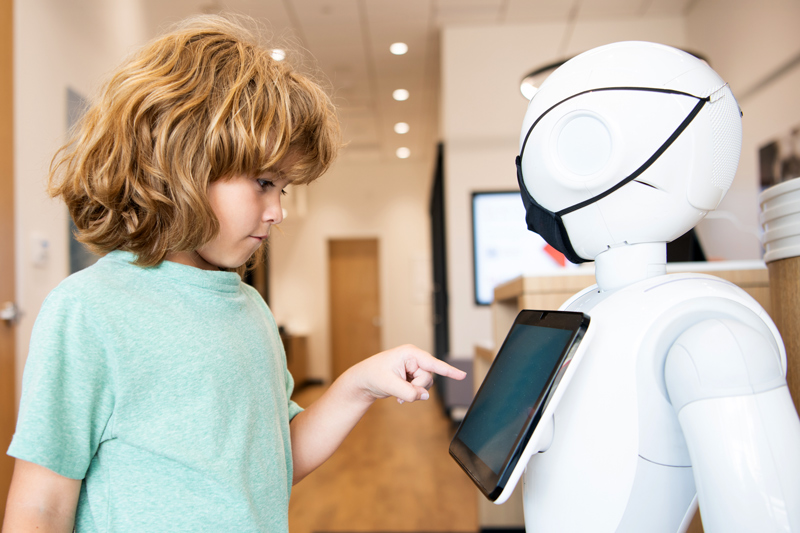I’ve always been a believer that big challenges can be solved with creative ideas that leverage the best that people and technology have to offer, and this time, I can’t think of a more critical challenge to address than safeguarding the mental health of our children. Our world is evolving at breakneck speed, and it’s heartbreaking to see the escalating number of young people who are struggling. We urgently need to provide them with effective, real-world support.

According to the Centers for Disease Control and Prevention (CDC), anxiety and behavioral issues frequently overlap with childhood depression: about 74% of children experiencing depression also deal with anxiety, and 47% grapple with behavioral problems. And in a 2023 CDC study, 22% of high school students reported having seriously considered suicide in the previous year.
Technology has already proven to be a powerful force in improving mental health care, especially with new and increasingly effective tech-based solutions emerging all the time. This trend will enable us not only to reach more kids but to enhance the support they receive. That’s why I believe digital tools are so important in addressing the mental health crisis among our youth.
The Growing Need for Digital Mental Health Solutions
Children and adolescents today live in a fast-paced, hyper-connected environment where online and offline stressors can blur into one another. I’ve witnessed schools, community groups, and health providers wrestling with the overwhelming need for mental health resources. Because of long waitlists and a scarcity of specialized professionals, many families are now turning to alternative solutions.
Digital mental health tools can help bridge these gaps. Apps and online platforms that provide screening, self-help modules, and peer support forums offer timely, on-demand assistance. They work in tandem with traditional services, making it easier for mild to moderate cases to find help more quickly. Early intervention can often stave off more serious problems later on—and I believe the private sector has a vital role to play in championing comprehensive, technology-driven approaches.
Expanding Access to Teletherapy and Online Counseling
When in-person therapy is in short supply or scheduling becomes a nightmare, teletherapy can be a much-needed lifeline for families. More than half of therapy sessions are now occurring online via teletherapy, and health plan coverage of teletherapy sessions is becoming more standard. Access to teletherapy reduces barriers related to travel, location, and social stigma. For young people in particular, they are often more comfortable connecting with mental health professionals in the comfort of their own space, allowing them to open up more freely.
Additionally, many online counseling platforms employ licensed therapists who specialize in working with children and teens. Flexible appointment times, the potential for more frequent sessions, and, most importantly, their adherence to evidence-based treatment practices proven to produce the best outcomes for youth and teens set these platforms apart from many in-person practices. Plus, streamlining administrative tasks like intake forms, insurance paperwork, and scheduling helps teletherapy providers minimize overhead, which in turn can lower costs and increase efficiency.
How Schools Can Integrate Digital Resources for Student Well-Being
Schools are uniquely positioned to identify mental health needs early on and respond proactively to help students. One tested and proven method is supplying school counselors and nurses with digital tools for initial mental health screenings. Online questionnaires and assessments can catch warning signs sooner and guide students toward the best possible care.
Schools can also incorporate evidence-based apps that focus on coping strategies, mindfulness, or resilience. These resources typically work best when folded into a broader web of support, such as routine teacher check-ins and referrals to mental health specialists. Training faculty and staff to know when and how to discuss mental health challenges with students and to be effective “mental health allies” who can refer them to appropriate resources has proven to be effective in both K-12 and higher education settings. Embedding digital solutions into health classes, after-school clubs, and parent outreach programs can also have a meaningful impact.
Of course, technology can’t replace human relationships, but it can greatly enhance how services are provided. For instance, school-facing portals that are protected by strict privacy safeguards can track student progress over time. This makes it easier for counselors to keep tabs on how they’re doing. From a business standpoint, collaborating with schools provides a clearly defined audience for high-impact, scalable solutions.
Challenges and Considerations in Implementing Tech-Based Mental Health Services
Even though digital mental health tools show great potential, major obstacles still exist. First is privacy. Because younger users are involved, extra care must be taken to protect their data and ensure compliance with regulations like HIPAA and COPPA. As companies gather sensitive information, keeping it secure is paramount to maintaining public trust.
Second, equitable access is a hurdle for many. Families in rural areas or with limited resources may lack reliable connectivity or suitable devices. If we want real progress in addressing mental health challenges, closing the digital divide is absolutely essential. Investing in broadband expansion, distributing mobile devices, and providing educator training are all key ways to address these disparities. Rural areas are typically where trained therapists are most scarce, so teletherapy and digital apps are a huge part of the solution as long as we continue to work to provide broad access.
Another concern is that some families doubt the effectiveness of online interventions because they worry about impersonal, generic experiences, which is understandable. A growing area that has generated much debate is the rise of AI-driven mental health chatbots. While concern about the impersonal nature of chatbots is understandable, studies have concluded they have great potential to offer effective support in situations where real-world human interaction, such as connecting to friends, family, or professional counseling, is not preferred or possible to achieve. It’s crucial for businesses to invest in the continued optimization of these AI-driven tools as well as comprehensive training for therapists, teachers, physicians, and other healthcare workers to help them effectively utilize the full range of solutions that have proven to be effective.
In the end, we have to remember that digital options are part of a broader continuum of care. They’re excellent for early-stage support or enhancing ongoing therapy, but severe cases still require in-person intervention.
As we work to optimize these tools and tackle issues like access and privacy, I truly believe we are creating a future in which technology will play an increasingly effective role in nurturing and developing a stronger, more resilient younger generation. The time to invest in these solutions is now. Let’s bring them to a larger scale and keep our children’s mental health firmly at the forefront.
Scott Healy is CEO of Psych Hub. To contact the Psych Hub team, please reach out to info@psychhub.com or visit the website at psychhub.com.




